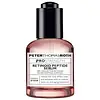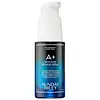What's inside
What's inside
 Key Ingredients
Key Ingredients

 Benefits
Benefits

 Concerns
Concerns

 Ingredients Side-by-side
Ingredients Side-by-side

C9-12 Alkane
SolventDimethicone
EmollientIsononyl Isononanoate
EmollientDimethyl Isosorbide
SolventTrisiloxane
Skin ConditioningCyclopentasiloxane
EmollientPolysilicone-11
Coco-Caprylate/Caprate
EmollientCaprylic/Capric Triglyceride
MaskingHydroxypinacolone Retinoate
Skin ConditioningPalmitoyl Hexapeptide-14
Skin ConditioningCeramide NP
Skin ConditioningHelianthus Annuus Seed Extract
Skin ConditioningHordeum Vulgare Extract
EmollientCucumis Sativus Extract
Skin ConditioningLaminaria Ochroleuca Extract
Skin ConditioningZingiber Officinale Root Extract
MaskingPhytosteryl Canola Glycerides
Skin ConditioningSodium Hyaluronate
HumectantSodium PCA
HumectantSqualane
EmollientTocopherol
AntioxidantLecithin
EmollientLinoleic Acid
CleansingOleic Acid
EmollientPalmitic Acid
EmollientStearic Acid
CleansingHydroxystearic Acid
CleansingTriolein
Skin ConditioningBisabolol
MaskingEthylhexyl Hydroxystearate
EmollientEthoxydiglycol
HumectantEthylhexylglycerin
Skin ConditioningWater
Skin ConditioningMica
Cosmetic ColorantPhenoxyethanol
PreservativeC9-12 Alkane, Dimethicone, Isononyl Isononanoate, Dimethyl Isosorbide, Trisiloxane, Cyclopentasiloxane, Polysilicone-11, Coco-Caprylate/Caprate, Caprylic/Capric Triglyceride, Hydroxypinacolone Retinoate, Palmitoyl Hexapeptide-14, Ceramide NP, Helianthus Annuus Seed Extract, Hordeum Vulgare Extract, Cucumis Sativus Extract, Laminaria Ochroleuca Extract, Zingiber Officinale Root Extract, Phytosteryl Canola Glycerides, Sodium Hyaluronate, Sodium PCA, Squalane, Tocopherol, Lecithin, Linoleic Acid, Oleic Acid, Palmitic Acid, Stearic Acid, Hydroxystearic Acid, Triolein, Bisabolol, Ethylhexyl Hydroxystearate, Ethoxydiglycol, Ethylhexylglycerin, Water, Mica, Phenoxyethanol
Water
Skin ConditioningPropanediol
SolventDimethyl Isosorbide
SolventTriheptanoin
Skin ConditioningDimethicone
EmollientGlycerin
HumectantPentylene Glycol
Skin ConditioningHexyldecanol
EmollientDisiloxane
Skin ConditioningCetyl PEG/PPG-10/1 Dimethicone
EmulsifyingDiheptyl Succinate
EmollientPropylene Carbonate
SolventHydroxypinacolone Retinoate
Skin ConditioningPPG-24-Glycereth-24
EmulsifyingPhenyl Trimethicone
Skin ConditioningRetinol
Skin ConditioningUbiquinone
AntioxidantHoney Extract
HumectantSodium Hyaluronate Crosspolymer
HumectantAlgae Extract
EmollientZingiber Officinale Extract
Skin ConditioningOpuntia Ficus-Indica Fruit Extract
Skin ConditioningBisabolol
MaskingButyrospermum Parkii Butter
Skin ConditioningPhospholipids
Skin ConditioningSaccharomyces Cerevisiae Extract
Skin ConditioningLecithin
EmollientSodium Acrylates Copolymer
Hydrogenated Polyisobutene
Emollient1,2-Hexanediol
Skin Conditioning4-T-Butylcyclohexanol
MaskingPolyglyceryl-10 Stearate
Skin ConditioningCaprylyl Glycol
EmollientHelianthus Annuus Seed Oil
EmollientSorbitol
HumectantCetylhydroxyproline Palmitamide
Skin ConditioningPolysilicone-11
Benzoic Acid
MaskingDehydroacetic Acid
PreservativeSodium Phytate
Glyceryl Polyacrylate
Polysorbate 80
EmulsifyingHydroxyphenyl Propamidobenzoic Acid
Skin ConditioningStearic Acid
CleansingBrassica Campestris Sterols
EmollientPvp
Emulsion StabilisingCapryloyl Glycerin/Sebacic Acid Copolymer
Skin ConditioningSodium Benzoate
MaskingAlcohol
AntimicrobialPotassium Phosphate
BufferingDecyl Glucoside
CleansingPhenoxyethanol
PreservativeHexylene Glycol
EmulsifyingPotassium Sorbate
PreservativeTocopherol
AntioxidantWater, Propanediol, Dimethyl Isosorbide, Triheptanoin, Dimethicone, Glycerin, Pentylene Glycol, Hexyldecanol, Disiloxane, Cetyl PEG/PPG-10/1 Dimethicone, Diheptyl Succinate, Propylene Carbonate, Hydroxypinacolone Retinoate, PPG-24-Glycereth-24, Phenyl Trimethicone, Retinol, Ubiquinone, Honey Extract, Sodium Hyaluronate Crosspolymer, Algae Extract, Zingiber Officinale Extract, Opuntia Ficus-Indica Fruit Extract, Bisabolol, Butyrospermum Parkii Butter, Phospholipids, Saccharomyces Cerevisiae Extract, Lecithin, Sodium Acrylates Copolymer, Hydrogenated Polyisobutene, 1,2-Hexanediol, 4-T-Butylcyclohexanol, Polyglyceryl-10 Stearate, Caprylyl Glycol, Helianthus Annuus Seed Oil, Sorbitol, Cetylhydroxyproline Palmitamide, Polysilicone-11, Benzoic Acid, Dehydroacetic Acid, Sodium Phytate, Glyceryl Polyacrylate, Polysorbate 80, Hydroxyphenyl Propamidobenzoic Acid, Stearic Acid, Brassica Campestris Sterols, Pvp, Capryloyl Glycerin/Sebacic Acid Copolymer, Sodium Benzoate, Alcohol, Potassium Phosphate, Decyl Glucoside, Phenoxyethanol, Hexylene Glycol, Potassium Sorbate, Tocopherol
 Reviews
Reviews

Ingredients Explained
These ingredients are found in both products.
Ingredients higher up in an ingredient list are typically present in a larger amount.
Bisabolol is famous for its skin soothing properties. It does this by blocking inflammatory signals, helping to reduce your body's reaction to irritation.
This ingredient also interferes with the process of hyperpigmentation. This can help with reducing dark spots and uneven tone.
Bisabolol is an antioxidant. Antioxidants help fight free-radicals. Free-radicals are molecules that may damage your skin cells. By fighting these free-radicals, Bisabolol may slow down signs of aging.
Studies have shown Bisabolol to have antimicrobial properties and may be a fungicide. These properties help preserve a product's shelf life.
All these properties makes bisabolol a great skin barrier helper ingredient.
Bisabolol also helps the absorption of other ingredients.
Note: Synthetic Bisabolol has been shown to be less effective.
Learn more about BisabololDimethicone is a type of synthetic silicone created from natural materials such as quartz.
What it does:
Dimethicone comes in different viscosities:
Depending on the viscosity, dimethicone has different properties.
Ingredients lists don't always show which type is used, so we recommend reaching out to the brand if you have questions about the viscosity.
This ingredient is unlikely to cause irritation because it does not get absorbed into skin. However, people with silicone allergies should be careful about using this ingredient.
Note: Dimethicone may contribute to pilling. This is because it is not oil or water soluble, so pilling may occur when layered with products. When mixed with heavy oils in a formula, the outcome is also quite greasy.
Learn more about DimethiconeDimethyl Isosorbide is a solvent and helps deliver actives into your skin. It is created from sorbitol.
As a solvent, dimethyl isosorbide helps dissolve other ingredients. This helps ensure even distribution of an ingredient. It may also be used to decrease the thickness of a product.
Studies show dimethyl isosorbide is able to penetrate skin to deliver other ingredients into the skin, making them more effective.
Learn more about Dimethyl IsosorbideThis ingredient is a retinoid. It usually goes by a more common name: "Granactive".
Hydroxypinacolone Retinoate (HPR) belongs to the class of retinoids that also includes retinol and tretinoin.
Retinoids have been proven to:
So what is the difference between all the retinoids?
Most retinoids need to go through a conversion line to become effective on skin. The ending product is retinoic acid. Retinoic acid is AKA tretinoin.
HPR is an ester of tretinoin. Emerging studies suggest HPR to have an added benefit that other retinoids don't have: Low irritation.
A study from 2021 found HPR to have the greatest stability when exposed to light and temperature out of all the commercial retinoids.
A note about naming:
The name "Granactive" is the trade name and the name most commonly used on packages.
Granactive is the name of the mixture - about 90% solvent and 10% HPR. A product with 5% granactive has 0.5% HPR.
Learn more about Hydroxypinacolone RetinoateLecithin is a term for a group of substances found in the cell membranes of plants, animals, and humans. They are made up of mixture of phospholipids.
This ingredient has emollient and emulsifying properties.
As an emollient, lecithen helps soften the skin and creates a barrier to keep moisture in.
As an emulsifier, it also helps prevent water and oil ingredients from separating. Lecithin can also help ingredients be better absorbed by the skin.
This is because the phospholipids in lecithin produce liposomes. Liposomes help other ingredients get through the skin barrier.
Depending on the source of this ingredient, lecithin may not be fungal acne safe. This is because some sources of lecithin come from soybean oil, which may feed the malassezia yeast that feeds fungal acne.
We recommend reaching out to the brand you are purchasing from to inquire about the source of their lecithin.
Some other names for this ingredient include soy lecithin and deoiled soy lecithin.
Learn more about LecithinPhenoxyethanol is a preservative that has germicide, antimicrobial, and aromatic properties. Studies show that phenoxyethanol can prevent microbial growth. By itself, it has a scent that is similar to that of a rose.
It's often used in formulations along with Caprylyl Glycol to preserve the shelf life of products.
Polysilicone-11 is a film-forming silicone that creates a non-tacky and matte finish on the skin. It's commonly used to improve texture, absorb excess oil, and help active ingredients spread evenly.
Due to its "rubber-like" structure, it stays on the skin's surface instead of being absorbed. On the skin, it creates a flexible layer that enhances wearability and stability.
Stearic Acid is a fatty acid. It is an emollient, emulsifier, and texture enhancer.
As an emollient, stearic acid helps soften skin. It aids the skin's protective barrier by preventing water loss. It also provides a gentle cleansing effect without stripping away natural oils.
Stearic acid may also be used to enhance the texture of products. It can add volume and stabilize ingredients such as water and oil. This can help water and oil ingredients from separating.
Sources of stearic acid include animal or vegetable fats/oils such as coconut or shea. It can be naturally found in butter, cocoa butter, shea butter, vegetable fats, and animal tallow.
This ingredient may not be Malassezia folliculitis, or fungal-acne safe.
Learn more about Stearic AcidTocopherol (also known as Vitamin E) is a common antioxidant used to help protect the skin from free-radicals and strengthen the skin barrier. It's also fat soluble - this means our skin is great at absorbing it.
Vitamin E also helps keep your natural skin lipids healthy. Your lipid skin barrier naturally consists of lipids, ceramides, and fatty acids. Vitamin E offers extra protection for your skin’s lipid barrier, keeping your skin healthy and nourished.
Another benefit is a bit of UV protection. Vitamin E helps reduce the damage caused by UVB rays. (It should not replace your sunscreen). Combining it with Vitamin C can decrease sunburned cells and hyperpigmentation after UV exposure.
You might have noticed Vitamin E + C often paired together. This is because it is great at stabilizing Vitamin C. Using the two together helps increase the effectiveness of both ingredients.
There are often claims that Vitamin E can reduce/prevent scarring, but these claims haven't been confirmed by scientific research.
Learn more about TocopherolWater. It's the most common cosmetic ingredient of all. You'll usually see it at the top of ingredient lists, meaning that it makes up the largest part of the product.
So why is it so popular? Water most often acts as a solvent - this means that it helps dissolve other ingredients into the formulation.
You'll also recognize water as that liquid we all need to stay alive. If you see this, drink a glass of water. Stay hydrated!
Learn more about Water